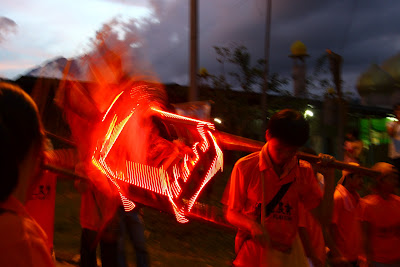Last weekend, Ranau played host to Sabah's Wesak celebration. This was quite an honour, as it hasn't been celebrated in Sabah since the 1980s; the precise date and place was determined by Chinese astrologers (in combination, says the cynical side of me, with the commercial need to have it on a weekend in a large town...) and Ranau came out best. The Chinese Buddhist temple has been undergoing a thorough spring cleaning over the past month or so, and on Saturday night it looked radiant. Temples in Sabah pale in comparison with the richly painted Korean temples, and are mere toddlers in the scheme of things - I believe this one dates back a few decades, while some of the Korean ones I visited were centuries old. But Ranau's temple has some beautiful paintings inside, and on the outside some impressive statues, and it's kept spotlessly bright and cheerful by volunteers. And I like the way that it stands at the top of a very short street that also accommodates an Anglican church and the town mosque. We watched the parade standing across the road from the mosque, and were thus constantly reminded of the balance between the national religion and others.
So. Wesak Day. Wesak Day is also known as Buddha's Birthday, and it's generally a public holiday across most of Asia, time for Buddhists to meditate on his teachings and life.
In Ranau it was time for a great big assault on the senses - incense, drums, shouting, whistles, bright neon lights all had their parts to play. The Lion Dance made another appearance too; they leapt and growled and shook at the front of each section of the procession.
In the heat of the late afternoon, the dancers took it in turns. When not dancing, they took over as musicians, still dressed in the lions' legs. The pink pom-poms on toes were particularly appealing.
The noise was astounding - Fiona and I had to shout to each other to be heard sometimes over the drums and tambourines and whistles.
The parade began at sunset with various groups from across Sabah walking down the hill. A lot of them were elderly Chinese men with huge banners proclaiming their origins, who laughed and pointed at us and called out "Welcome to Malaysia!" Other groups were young, wearing Buddha costumes and carrying flags on bamboo poles.
The flags, intricately embroidered with dragons and flowers, were entirely in the lucky colours of reds and oranges, and they absorbed and enhanced the colours of the setting sun.
As the darkness settled, the celebrations became more intense and religious. There were men walking down the street, seemingly in the grip of seizures, each one surrounded by three more men, holding their arms out, confining the babbling, gesticulating man. This was a more Malaysian version of Buddha's Birthday, and not one I saw in Korea. The central man calls down the spirits, the gods, into his body. They thrash around, using his bamboo whip to lash out at human beings. The three guards are preventing the gods from escaping and wreaking havoc on the town. The procession makes a full circle through the town to keep the balance and to symbolically close the loop of protection that is created by allowing the gods to have their way for a few short hours.
Some groups bore wooden boxes in the shape of temples, lit up in chains of neon lights. The boxes were rocking wildly; the young Buddha was inside, playing, and messing with his carriers.
Sometimes he made his carriers shoot off out of the procession, careering madly around the roundabout, handily situated at the bottom of the street.
After the procession had made its way around town, we walked up to the temple and sat for a while at the courtyard fountain. Although this was a strictly Chinese Buddhist celebration, there were all sorts of onlookers - kids still in school uniform, elderly women in Malay sarongs, Catholic nuns, and most of Fiona and my students and teachers - walking from A to B took a looooong time as we stopped to chat and say hello.
Inside the temple, men and women lit joss sticks and carried them to pictures of different deities to pray before.
The next day when I drove down the mountain to K.K., I drove the whole way behind a procession of cars billowing silk from the windows and carrying piles of red wooden boxes and bamboo sticks in the back seats.














No comments:
Post a Comment